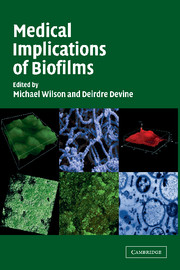Book contents
- Frontmatter
- Contents
- Preface
- List of Contributors
- PART ONE INTRODUCTORY CHAPTERS
- PART TWO BIOFILMS ON PROSTHETIC DEVICES
- PART THREE ORAL BIOFILMS
- 8 Novel Microscopic Methods to Study the Structure and Metabolism of Oral Biofilms
- 9 Oral Streptococcal Genes That Encode Biofilm Formation
- 10 Gene Expression in Oral Biofilms
- PART FOUR BIOFILMS ON SHEDDING SURFACES
- Index
- References
9 - Oral Streptococcal Genes That Encode Biofilm Formation
Published online by Cambridge University Press: 23 November 2009
- Frontmatter
- Contents
- Preface
- List of Contributors
- PART ONE INTRODUCTORY CHAPTERS
- PART TWO BIOFILMS ON PROSTHETIC DEVICES
- PART THREE ORAL BIOFILMS
- 8 Novel Microscopic Methods to Study the Structure and Metabolism of Oral Biofilms
- 9 Oral Streptococcal Genes That Encode Biofilm Formation
- 10 Gene Expression in Oral Biofilms
- PART FOUR BIOFILMS ON SHEDDING SURFACES
- Index
- References
Summary
INTRODUCTION
Oral Biofilms
Biofilms are surface-attached bacterial communities formed by unicellular organisms of single or multiple species. Most bacteria in their natural ecosystems colonise surfaces and are found in biofilm communities, rather than as planktonic cells. Biofilm formation is a highly structured process that occurs for numerous reasons, including protection from host immune systems, nutrient availability, and protection from harsh changes in the environment (Costerton et al., 1995; Costerton, Stewart, and Greenberg, 1999). A number of studies examining planktonic cells grown in batch culture have usually treated bacteria as unicellular species, even though they often exist in biofilms.
Although biofilm formation has been recognised and documented for approximately 100 years, we are just beginning to understand this process at the molecular level. Increasingly, bacteria have been studied as multicellular populations and, in some cases, viewed as interactive multicellular organisms (Shapiro, 1998), partly due to the fact that biofilm cells exist in a physical and physiological state that can increase their resistance to antimicrobials and mechanical forces (Costerton et al., 1995, 1999). Bacteria in a biofilm often display a dramatically different phenotype when compared with their counterparts in liquid culture. For example, biofilm cells often display higher resistance to antimicrobial agents, and they often exist in localised anoxic microenvironments and/or microenvironments that vary significantly in pH and ionic strength (Costerton et al., 1995, 1999).
- Type
- Chapter
- Information
- Medical Implications of Biofilms , pp. 189 - 211Publisher: Cambridge University PressPrint publication year: 2003
References
- 3
- Cited by



